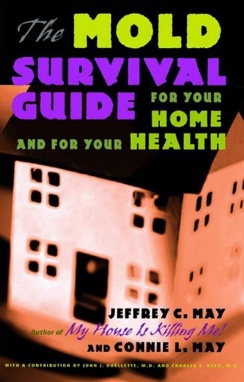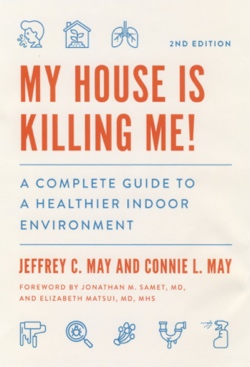Homeowner Newsletter: Summer 2021
©2021 Jeffrey C. May
I am an indoor air quality (IAQ) professional, but I was first an organic chemist and teacher, and then a contractor and building inspector: paths that may seem incongruous, but the knowledge I gained from these prior experiences now assists me when I investigate building problems. One of those problems is the increase of volatile organic compounds (VOCs) found in indoor environments. In this article, I am going to concentrate on what you can do to reduce chemical exposures in your home, starting with some sources of chemical odors.
Leaking gasoline cans and gasoline-fueled vehicles stored in attached garages as well as fuel-oil leaks in basements can send VOCs into habitable rooms in the house. Gas stoves and gas fireplaces can also leak; and the smell of gas can make some people feel sick.


In one home, the basement reeked of VOCs. There was a gasoline station next door to the house, and at least one of the underground gasoline tanks was leaking. The fuel was migrating through the soil, and fumes entered this basement through a crack in the foundation floor.

Another client had just purchased a new property but feared staying there because she got terrible headaches whenever she spent time in the house. I found that the furnace was emitting carbon monoxide. The gas company’s warning tag was sitting on top of the furnace, hidden from view; someone had removed the tag from the gas valve. In my opinion, removing that tag put that woman’s life in jeopardy.
Items (like window screens) made of flexible vinyl can emit a strange chemical odor when heated by the sun. Floor mats placed on carpeting under office chairs are made of vinyl, which may contain xylene that has the smell of new shower curtains. Some people find this smell sickening.
If you have a home office and have a photocopier, you may have noticed that the machine emits an odor when you make a lot of copies at the same time. Some of this odor is caused by ozone: a potentially irritating gas. Some air purifiers – the ones described as “ionizing” – also emit ozone: one of the chief components in smog.
Area rugs – especially those manufactured in China – can have a thin layer of non-slip backing that contains improperly vulcanized rubber, which emits a sulfur odor similar to that of a new tire – a smell that some people find noxious. New carpeting can release solvents and other chemicals into the air, including 4-phenylcylohexene (4-PC), which can cause neurological symptoms in some people. This issue first came into the public eye after the EPA was forced to replace 27,000 square yards of stinky carpeting from their DC headquarters. My wife and I once had new carpeting installed on a staircase. I had chosen that particular carpet because I went to the back of the store and gave each roll a “sniff test.” I did not care about the color or the pile of the carpet, just the odor. Well, the store installed the carpet type that we chose but a different batch of it, and the carpet odor was very strong. The carpet still reeked after months of airing out the staircase with fans and open doors. I had to hold my breath in the stairwell, and it took over four years for the carpet emissions to reach a level I could tolerate (I have chemical sensitivities).
I once investigated a building that contained an unpleasant fishy odor. The odor source was closed-cell spray polyurethane foam (SPF) insulation. This kind of insulation is very effective, but if not installed properly it can cause unpleasant odors – some of which are so strong that homeowners choose to remove all the insulation or even abandon the homes altogether. In one case I investigated, a contractor bought a renovated home to which odorous SPF insulation had recently been installed in the attic; he removed the entire roof structure rather than remediate the attic.

I investigated another house where the owners got headaches after spending time in the basement. A drop ceiling concealed the framing, which consisted of I-joints that have an OSB (oriented strand board) web. As far as airflows were concerned, though, the beams might as well have been exposed, because the formaldehyde that they were emitting was mixing with the air and flowing down into the habitable, basement rooms.
Other building components can emit irritating odors. Paints and adhesives emit solvents. Some black rubber PVC couplings (again made in China) emit powerful sulfurous chemical odors.
Even joint compound can be problematic. In one house I investigated, built by a couple as their “green” dream-retirement home, the wife had moved out and was living in an apartment – not because she and her husband had separated, but because after spending more than a few minutes in the house she experienced headaches. The house was modern, open and sun-filled, but it also contained a strong chemical odor at the first floor – strongest every sixteen inches in vertical bands along the walls and at both exterior and interior drywall corners. It turned out that fungicide had been added to the joint compound used on the first floor, and the fungicide was diffusing through the paint layer. The woman was obviously sensitive to the chemical.
The answer? If she wanted to move back into the house, the first-floor joint compound and/or drywall had to be removed and replaced or covered with Denny Foil (paper with foil on one side) and then covered with new drywall.
A new home or one that is newly renovated can smell strongly of paints, varnishes and new carpeting, etc. To speed off-gassing of these chemicals, the home has to be well ventilated. This requires not only opening windows, but also operating a fan on exhaust in one window and a fan on supply in another, to increase the ventilation rate. (To enhance evaporation of VOCs, several box fans or oscillating floor fans should be directed at surfaces to reduce the “boundary layer” of air that slows down VOC emissions from surfaces.)
Odors often linger in finished basements because the windows are inadequately sized for ventilation. One axial blower (such as a radon fan) with a duct can be used to bring in fresh air, and another fan used to exhaust contaminated air.
But even with the best ventilation, if you have chemical sensitivities it’s best to choose no-VOC paints, sealants and carpeting, because even with the best ventilation, such odors may linger for a long time. One fact to keep in mind about no-VOC paints, though, is that this designation often only refers to the base paint. If you chose a dark color that requires the addition of tints, you may end up with a VOC-emitting coating, as tints from most manufacturers contain VOCs. Check to be sure you will be getting no-VOC tints that some manufacturers now sell.
Fragrances may be pleasing to some people, but they are chemicals that can be irritating to others. If you have chemical sensitivities, sometimes it can feel as if the world is against you. People you pass on the street might smell of the fragranced shampoos or body lotions they use. If they use heavily fragranced laundry detergents or dryer sheets, their clothing can smell accordingly. Stores that sell fragranced candles are full of VOCs.
Fragranced candles can help create a comforting ambience in your home, but it is best to avoid using them, because they introduce chemicals (and soot that can blacken walls and ceilings) into the indoor air.
More than one in twenty people (more than 5%) are hypersensitive to chemicals in our environment. This may not sound like a lot of people to you, but that’s not too far behind the number of people (about 7%) who have asthma. You may be one of those people without knowing it. Do you find fragrances irritating? Do you have trouble walking into a hardware store that sells pesticides? Or down a supermarket aisle where fragranced laundry detergents are shelved? Even if inhaling chemicals doesn’t bother you, it’s still not a good idea to introduce chemicals into the air in your home because over time, such exposures can lead to sensitization.
Here are some tips for minimizing chemicals in your home environment:
- If you are planning on renovating your home or having a new home constructed, use no-VOC paints. As a test, acquire a small sample of paint that you’d like to use, apply it to a scrap of wood, and see if the dried paint off-gasses an odor that you find irritating.
- Don’t strip or varnish furniture inside the house.
- After a room has been painted, air out the space.
- Avoid carpeting; solid flooring is preferable.
- When buying area rugs, be sure that the backing doesn’t emit a rubber odor.
- If you are sensitive to formaldehyde, buy solid-wood furniture and kitchen cabinets.
- Don’t store gasoline, pesticides, rubber tires, fertilizers (which can contain pesticides), or pool chemicals in your basement or in a garage that is attached to your house.
- If you have an attached garage, don’t let your car’s engine idle in the space.
- If you have oil heat, be sure that the tank is not leaking, and call the oil company if any oil spilled when the tank was filled.
- If you are considering having spray polyurethane foam (SPF) insulation installed in your home, hire an experienced installer who has been doing this kind of work for at least five years. And don’t remain in the house while the work is going on. Ask the installer how long you should stay away (usually a day or two) before moving back in.
- Don’t burn fragranced candles or use plug-in fragrance emitters.
- Don’t use fragranced body and cleaning products. Ask members of your family to avoid using such products.
- If you find the odor of plastic irritating, avoid bringing shower curtains and floor mats (for under office chairs) that emit this odor into your home; or air them out first before bringing them inside.
- If you work in your home office full-time, it’s a good idea to put your photocopier as well as your laser printer in a well-ventilated spot (“Photocopiers and Laser Printer Health Hazards,” Health and Safety Department, University of Edinburgh, 4/19/2010).
- When you travel, hotels rooms are “homes away from home.” Don’t stay in a hotel that is undergoing renovation; try to find a hotel where the windows are operable. If you or anyone traveling with you has mold allergy, don’t operate the heating/cooling system if you can avoid it (a potential exposure to mold, not chemicals). Cleaners often use heavily fragranced cleaning products that can be irritating to those who have chemical sensitivities, so ask that your room not be cleaned during your stay.
RESOURCES for people with MCS (multiple chemical sensitivities)
- The Chemical Sensitivity Foundation, www.chemicalsensitivityfoundation.org
- Environmental Health Center, Dallas, TX, http://www.ehcd.com/
- Massachusetts Association of the Chemically Injured, www.maci-mcs.org
This information is included to help you with your research. I offer no warranty regarding the quality of the work that these organizations do. As with all matters that have to do with your health, research such resources carefully and thoroughly, and confer with your personal physician.
Refer to our books for further guidance, published by Johns Hopkins University Press and available on line.



